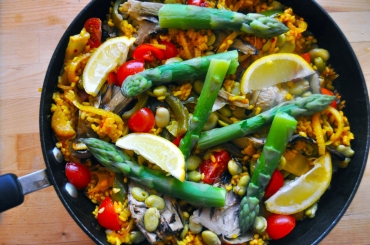Friday 6 May
I think a lot of British people associate paella with being a seafoody dish, probably because of summer holidays on the Spanish coast. In fact it’s originally a regional dish from Valencia and, over time, has been made with almost anything that you can throw into a pot – snails, rats, pork, chicken and, yes, seafood, as well as a whole host of vegetables. Peppers, butter beans, artichokes and cauliflower are all popular additions to a paella. Ours tends to change with the seasons. In winter, a paella with cauliflower, peppers and butter beans is a fantastic thing. This spring, I threw the some of the contents of our seasonal veg box at it, plus a few other bits and pieces from the fridge. Not exactly traditional, perhaps, but then dishes like this can be varied ad infinitum.
A paella differs from a risotto in that, as the rice is cooking in its broth, you don’t stir it. There’s no sauciness to a paella, it’s a much drier dish than a risotto and so more closely resembles a biriani. Indeed, an authentic paella – especially one cooked outdoors over charcoal, will develop an almost crispy layer of rice at the bottom of the pan. Oh, and you need to use either calasparra or bomba varieties of rice or it won’t work.
Our version this week? Sautee a finely sliced onion in olive oil in a wide, shallow pan until it is golden and soft. Add a thinly sliced bell pepper to the pan (seeds removed of course) plus a clove of garlic and cook for a further five minutes or so. Add the bomba or calasparra rice and coat in the olive oil. Add a generous glug of sherry or white wine, or a splash of sherry vinegar of white wine vinegar. Cook for three minutes. Now add a good pinch of saffron strands, a large teaspoon of paprika, a small teaspoon of smoked paprika and half a teaspoon of turmeric. Oh and a bay leaf. Stir in the spices to coat the grains of rice. Add hot water until it comes up a centimetre or so above the rice. Turn down the heat slightly and leave (really, don’t touch it!) until the broth has been absorbed. When it’s done the rice grains should have a pleasing sheen to them and be individual, separate, glistening grains and, while cooked, not puddingy. It will take about 20 minutes.
While the rice is cooking, lightly steam a few asparagus spears, refresh under cold water and set aside. Then blanche and shell some broad beans. As the rice nears the end of its cooking add the beans and some (tinned – they’ll be fine) artichoke hearts. Be careful not to move the rice around to much as you add the veg. They just need to be warmed through, that’s all.
When the rice is cooked add some quartered cherry tomatoes, wedges of lemon (squeeze them slightly into the dish) and place the asparagus spears on the top. Serve.
We always make too much of this and are quite happy to eat the remainder the following day. It works really well.
As for quantities, I’m going to talk about recipes and quantities soon, honest.






Recipe: Broad bean and herb salad
Funny old things, broad beans. And a little frustrating too. The discrepancy in volume between their fully podded selves and the individual, edible bean is huge. I’ve heard some people complain that they don’t like oranges because peeling them is too much effort. If you’re one of those people, then you’re going to miss out on the wonders of fresh, in-season broad beans. We love them. Of course, frozen, de-podded broad beans are available, but somehow the effort of removing the beans from the pods, blanching them in boiling water for a couple of minutes and then slipping the bright green beans from their skins can be all part of the pleasure.
In any case, when broad beans start turning up in recipes for salads in the weekend papers, then you know it’s definitely spring and almost the beginning of summer. This Yotam Ottolenghi recipe, here, adds pearl barley to a salad of broad beans and herbs – a nutty addition that also makes for a more substantial salad.
Posted in Barley, Beans, Comment, Recipes, Salads, Veg in season | Leave a Comment »